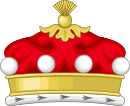| Baron Fisher of Kilverstone | |
|---|---|
  Blazon
| |
| Creation date | 14 December 1909 |
| Created by | Edward VII |
| Peerage | United Kingdom |
| First holder | John Fisher, 1st Baron Fisher |
| Present holder | Patrick Fisher, 4th Baron Fisher |
| Heir apparent | Hon. Benjamin Carnegie Vavasseur Fisher |
| Remainder to | 1st Baron's heirs male of the body lawfully begotten |
| Status | Extant |
| Seat(s) | Kilverstone Hall |
| Motto | Fear God and Dread Nought |

Baron Fisher, of Kilverstone in the County of Norfolk, is a title in the Peerage of the United Kingdom. It was created in 1909 for the noted naval reformer Admiral of the Fleet Sir John Fisher. [1]
Contents
His son Cecil Fisher, the second Baron, was the adoptive heir of Josiah Vavasseur (1834–1908), an arms manufacturer. Vavasseur left part of his enormous estate to Fisher on the condition that he adopt the Vavasseur name; Fisher assumed the additional surname of Vavasseur in 1909 by royal licence. As of 2017 [update] the title is held by his grandson, the fourth Baron, who succeeded in 2012.
The family seat is Kilverstone Hall, near Kilverstone, Norfolk.
